Just yesterday we published my review of the ERECTOR by Q, in which I stated that there was nothing like it on the market. Well, apparently I missed the ~July 4th release of Thompson Machine’s new Horizon. This .22 LR suppressor is comprised of a titanium mount plus 10 aluminum baffles (four long and six short) and an aluminum front cap.
Mix, match, and assemble the suppressor from one to 10 baffles to suit your length, weight, and sound suppression needs.
Horizon stats:
Caliber…………………………22lr
Overall Length………………..6.85” (Full 10 Baffle Stack)
Weight…………………………3.8oz
Baffle Material…………………7075 Space T6 Aluminum
Base Cup Material………………..Grade 5 Titanium (6AL-4V)
Design…………………………Modular, Take-apart, No Special Tool Needed
Finish…………………………..Matte Bead Blast Natural Titanium/ Matte Black Anodized (add $50)
MSRP………………………….$449

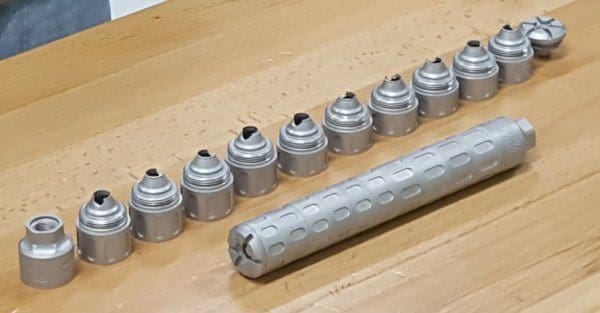
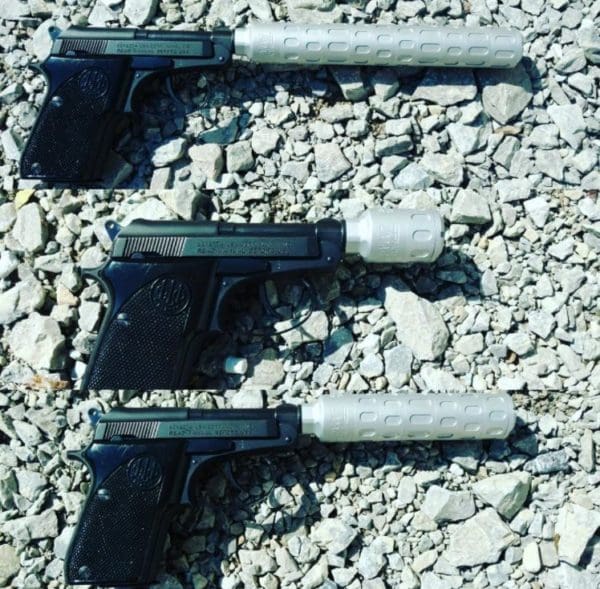
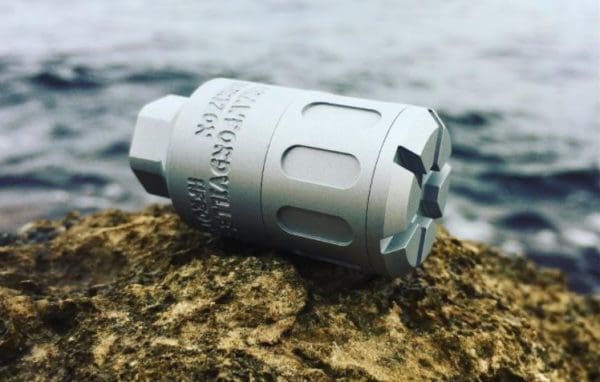
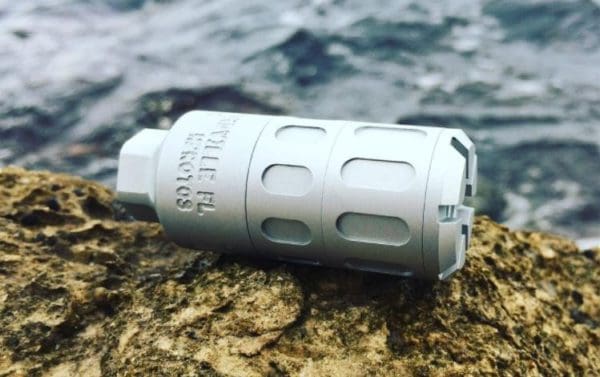
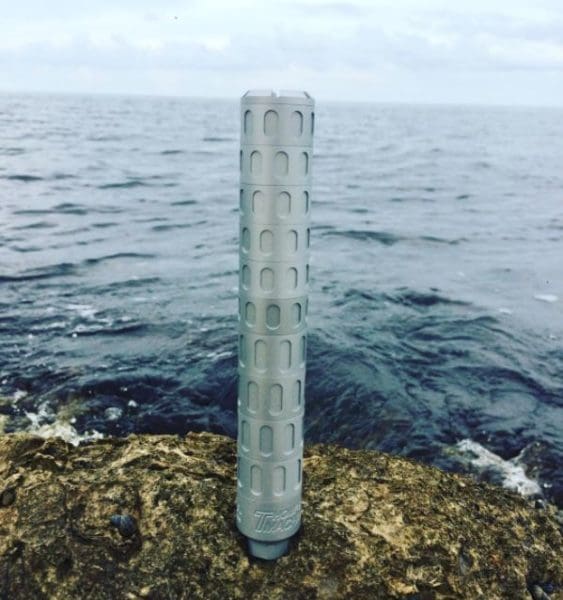



Would using something like an anti-seize compound on the threads be a viable way to keep it from being ‘glued up’ with carbon?
Yes. Antiseize is great to keep them coming apart.
It’s only a .22 can and is unlikely to get very hot. I’d probably just use my normal gun lube or CLP on the threads.
It’s relatively typical for people to use anti-seize on the muzzle threads of centerfire rifles, though, if they’re taking the can off semi-regularly (e.g. for barrel cleaning).
Hmmm. Shorter than the Q, one more baffle, no special tools to lose, and fifty bucks cheaper.
Now if your common core math regarding wait times is correct, looks like I have another can in my (next week), future.
(Thanks for thrashing my ammo budget again Jeremy!)
It isn’t really one more baffle, it’s just that this one doesn’t have a dedicated blast baffle so there are ten that you can move around, whereas the Erector has a fixed blast baffle and nine that you can move around. The Erector has a stainless steel blast baffle, whereas this TM can is 100% aluminum (in another video they suggest moving baffles around so they all share time playing blast baffle and therefore wear evenly). The end cap on the TM accepts a hex wrench but there’s no tool for helping take apart the baffles. The end cap on the Q accepts a socket wrench or box wrench and it comes with tools for the baffles if needed (it usually shouldn’t be).
Can anyone answer the question of why you would want to utilize aluminum at all in this design? If they’re using titanium to begin with, why would they bring aluminum into the final product? Is it only to save cost? Titanium transmits heat well, but not quite as well as aluminum. Titanium is more expensive to machine, but it will last longer. I just don’t see how it is in the customer’s best interest to purchase this muffler when they will have to replace parts more often, the parts with the greatest pressures are prone to wear faster, and there is a greater chance of incidental damage.
$450 is a bit much for something that is not revolutionary and made with such inexpensive materials, I guess this applies to quite a few of the suppressors out there on the market. These things should be very inexpensive now.
“Can anyone answer the question of why you would want to utilize aluminum at all in this design?”
The sheer mass of it gets to be problematic for the shooter on both handguns and long guns.
It screws up the ability to quickly change the point of aim. You tend to overshoot and have to reverse direction back a bit.
And yes, there is a *substantial* difference in the cost of the metal feedstock and the ease and speed of machining it.
An ‘ideal’ can would be as short as possible, that’s what make integrally-suppressed guns like the 10/22 takedown with the aftermarket barrel a very attractive proposition…
Thank you Geoff PR, I appreciate your response. I was meaning to ask specifically about why titanium was not used in the entirety of the suppressor instead of aluminum. I understand that it’s very light, but that’s not the end all be all. I’m not a fan of aluminum for my tools or other durables which endure hard use, simply due to its propensity to bend, bind together, and just generally suck at keeping shape under pressure. I wouldn’t make a muzzle brake out of aluminum, why this?
Well he answered the question by mentioning materials cost and machine hours cost. It would make this suppressor way more expensive than anyone would be willing to pay for it.
BTW you DO make muzzle brakes / compensators from aluminum if it’s for a .22 LR. The caliber simply doesn’t have the pressure or heat needed to cause undue wear in a brake/comp. ESPECIALLY if hard coat anodized. On thinner suppressor baffles with sharper, gas-facing edges, though, I do think it’s wise to use a more durable material for the blast baffle in particular and treat the aluminum parts to make the surface harder and more durable.
Dan, I just looked up the ‘spot’ price of aluminum and titanium.
Aluminum shows $0.50 per pound while titanium is $30 a pound.
That makes titanium *60* times more expensive than aluminum, per pound.
Factor in the much more expensive fussy machining costs and I can easily see why so few items sold are titanium.
“Most titanium alloys are poor thermal conductors. Heat generated during cutting doesn’t dissipate through the part and machine structure, but concentrates in the cutting area. The high temperatures that can be reached — 2,000°F in some cases — can lead to cutting edge chipping and deformation, and dull edges on tools generate even more heat and further reduce tool life. Cutting temperatures can get so high that titanium chips sometimes burst into flames.
The high temperature generated during the cutting process also causes a work hardening phenomenon that affects the surface integrity of titanium, and could lead to geometric inaccuracies in the part and severe reduction in its fatigue strength.”
http://americanmachinist.com/features/cool-tips-cutting-titanium
If these are machined from bar stock, you’re already looking at A LOT of machine hours. Ti would cost a fortune. If HPA passed I could see the potential increase in sales volume making production methods like MIM or investment casting viable, and then cheap and lightweight materials like aluminum would be even more appealing for silencers as presumably end users could purchase and replace individual baffles as they please, and on the cheap.
Frankly, I think aluminum baffles should always be Hard Coat Anodized anyway. That is, if there isn’t another viable, even harder treatment available like PVD (e.g. TiCN) or whatever else you can do to aluminum.
Agreed, 100%. The end users of this item would benefit greatly from putting a protective coating (anti-seize or silicone grease) over the threading of this suppressor, to prevent the aluminum from binding and making the suppressor permanently one length. Aluminum rubbing against itself tends to bind up, the closer the tolerances the worse the issue. Whatever coating the company puts on it will make a difference, but wear and tear will take that off of threading quickly.
Jeremy – any intention on testing Thompson Machine’s micro pistol silencer, the Poseidon?
Yeah, I’d love to test it and the GEMTECH Aurora 2 at the same time. I’ll bounce the idea off Silencer Shop, as they carry both brands.
Sweet! Hope they go for it.
Thompson Machine. Hard pass.
Cool, but compared to the Erector isn’t it about 25% heavier inch-per-inch and yet it doesn’t have the stainless steel blast baffle? Unless metering or long-term use reveals a hidden advantage it seems Q wins in performance. But thanks for letting us know that a competitor exists to the Erector, Jeremy. Shame on me for not keeping up with Thompson Machine’s latest offerings despite my affinity for their unique Poseidon suppressor, which with the right host rivals or even exceeds the Maxim 9 in compactness.
I just wish my Poseidon cans could use 2 spaced wipes instead of 1.
Comments are closed.